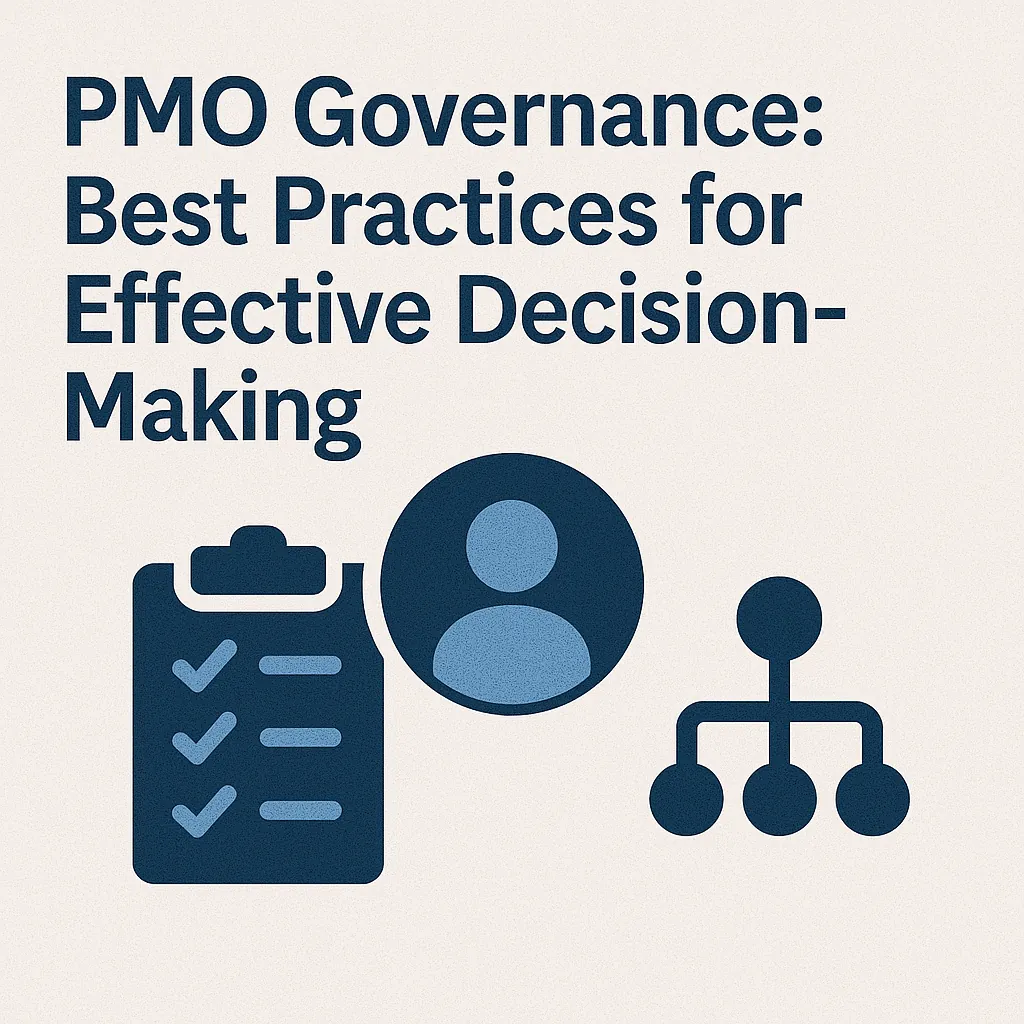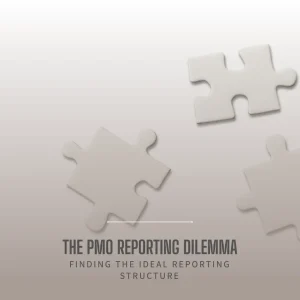Introduction to PMO Governance
The Project Management Office (PMO) plays a pivotal role in ensuring that projects align with an organization’s strategic objectives. A PMO is a centralized department that establishes and monitors standards for all projects undertaken by a company. It differs from project management, which focuses on the day-to-day tasks necessary to achieve specific deliverables. The PMO is responsible for overseeing project portfolios, ensuring that resources are allocated efficiently, and providing guidance to project managers to enhance project success rates [9].
Understanding Governance in PMOs
Governance within the context of PMOs refers to the framework of rules, processes, and decision-making authority that ensures projects are executed effectively and efficiently. It serves as a guiding structure that aligns project outcomes with the organization’s strategic goals, values, and standards. Governance in project portfolio management encompasses a set of policies and procedures that dictate how projects are managed, ensuring that they contribute positively to the organization’s overall mission [1][14].
Effective governance structures are essential for PMOs as they facilitate clear decision-making processes. This includes defining roles and responsibilities within the project team, establishing accountability, and ensuring that decision rights are appropriately assigned between project teams and executives. By doing so, governance helps to mitigate risks, enhance project visibility, and improve overall project performance [3][7][8].
The Need for Effective Governance Structures in Decision-Making
The importance of robust governance structures cannot be overstated, particularly in today’s complex project environments. Effective governance enables PMOs to navigate challenges and make informed decisions that support organizational objectives. It provides a framework for structured decision-making, allowing PMOs to surface and resolve key project decisions efficiently [13].
Moreover, as PMOs are increasingly challenged to demonstrate their value, implementing best practices in governance becomes crucial. These practices not only enhance the PMO’s ability to manage risks but also improve communication and collaboration among stakeholders, ultimately leading to better project outcomes [11][15].Eestablishing effective governance structures within PMOs is vital for ensuring that projects are aligned with strategic goals and are delivered successfully. By prioritizing governance, PMO directors and governance professionals can enhance decision-making processes, drive project success, and contribute to the overall effectiveness of their organizations.
The Importance of Governance in PMOs
Governance plays a pivotal role in the success of Project Management Offices (PMOs), serving as the backbone that supports effective decision-making and project execution. Understanding the relationship between governance and project success, recognizing the risks associated with inadequate governance, and illustrating its impact on stakeholder trust and engagement are essential for governance professionals and PMO directors.
Relationship Between Governance and Project Success
Effective governance structures are directly linked to project success. A well-defined governance framework ensures that project objectives align with organizational goals, facilitating better resource allocation and prioritization. Research indicates that high-performing PMOs, which implement robust governance practices, significantly enhance revenue and customer satisfaction, demonstrating a clear correlation between governance and project outcomes [1][9]. By establishing clear roles and responsibilities, governance frameworks enable streamlined decision-making, which is crucial for navigating the complexities of modern projects [4][15].
Risks Associated with Poor Governance
The absence of effective governance can lead to a myriad of risks that jeopardize project success. Poor governance often results in unclear decision rights and accountabilities, leading to confusion among project teams and stakeholders [8]. This lack of clarity can cause delays, miscommunication, and ultimately project failure. Additionally, organizations may face increased costs and resource wastage due to ineffective project oversight and management practices [10]. Without a structured governance approach, PMOs may struggle to demonstrate their value, further exacerbating the challenges they face in achieving strategic objectives [9].
Impact on Stakeholder Trust and Engagement
Governance significantly influences stakeholder trust and engagement, which are critical for project success. When governance structures are transparent and well-communicated, stakeholders are more likely to feel involved and valued, fostering a collaborative environment [11]. Conversely, poor governance can lead to skepticism and disengagement among stakeholders, undermining their confidence in the PMO’s ability to deliver results [12]. By implementing effective governance practices, PMOs can enhance stakeholder relationships, ensuring that all parties are aligned and committed to the project’s success [7][15].
Governance is not merely a bureaucratic necessity; it is a fundamental component that underpins the effectiveness of PMOs. By prioritizing governance, PMOs can mitigate risks, enhance project success, and build lasting trust with stakeholders, ultimately driving organizational success.
Key Governance Structures for PMOs
The effectiveness of a Project Management Office (PMO) is heavily reliant on its governance structures. These frameworks not only define how projects are managed but also ensure that decision-making processes are clear and efficient. Below are the essential components of PMO governance frameworks, the various models available, and the critical roles played by steering committees and advisory boards.
Governance Framework Components
A robust PMO governance framework consists of several key components:
- Roles and Responsibilities: Clearly defined roles are crucial for accountability and effective decision-making. This includes delineating responsibilities among project managers, PMO staff, and stakeholders. A RACI (Responsible, Accountable, Consulted, Informed) matrix can be an effective tool to communicate these roles to all involved parties [10].
- Processes: Governance processes should encompass all stages of project management, including initiation, planning, execution, monitoring, and closure. These processes must be adaptable and scalable to accommodate the varying needs of different projects while ensuring compliance with organizational standards [10].
- Communication: Effective communication strategies are vital for disseminating information and ensuring that all stakeholders are aligned with the PMO’s objectives. Regular updates and feedback loops can enhance transparency and foster collaboration [12].
Differentiating PMO Governance Models
PMOs can adopt various governance models, each with its own advantages and challenges:
- Centralized PMO: In this model, the PMO has full control over project management processes and resources. This structure allows for uniformity in project execution and decision-making, which can lead to increased efficiency and reduced risks. However, it may also result in slower response times to project-specific needs due to the centralized nature of decision-making [4].
- Decentralized PMO: A decentralized PMO allows individual departments or business units to manage their projects independently. This model can enhance flexibility and responsiveness to local needs but may lead to inconsistencies in project management practices across the organization [4].
- Hybrid PMO: The hybrid model combines elements of both centralized and decentralized approaches. It allows for a balance between standardization and flexibility, enabling organizations to tailor their governance structures to specific project requirements while maintaining overall alignment with strategic objectives [4].
Role of Steering Committees and Advisory Boards
Steering committees and advisory boards play pivotal roles in PMO governance:
- Steering Committees: These committees are typically composed of senior executives and key stakeholders who provide strategic direction and oversight for projects. They are responsible for making high-level decisions, resolving conflicts, and ensuring that projects align with organizational goals. Their involvement is crucial for maintaining stakeholder engagement and support throughout the project lifecycle [2].
- Advisory Boards: Advisory boards consist of experts who provide guidance and insights to the PMO. They help in assessing project feasibility, identifying potential risks, and recommending best practices. Their external perspective can be invaluable in enhancing the PMO’s effectiveness and ensuring that it remains aligned with industry standards and innovations [2].
Establishing a well-defined governance framework is essential for the success of a PMO. By clearly outlining roles, responsibilities, and processes, differentiating between governance models, and leveraging the expertise of steering committees and advisory boards, organizations can enhance their PMO’s effectiveness and ensure informed decision-making.
Best Practices for Effective PMO Decision-Making
Effective governance is paramount for ensuring that decision-making processes are not only efficient but also aligned with organizational goals. Here are some best practices that can enhance decision-making within PMOs, particularly for governance professionals and PMO directors.
1. Establish Clear Communication Channels
Effective governance hinges on the establishment of smooth communication pathways. Clear communication channels facilitate the flow of information among stakeholders, ensuring that everyone is on the same page regarding project objectives, roles, and responsibilities. This clarity is essential for accountability and helps streamline decision-making processes. By defining how information is shared and who is responsible for disseminating it, PMOs can reduce misunderstandings and enhance collaboration among team members and stakeholders [3][9].
2. Leverage Data-Driven Decision-Making
Incorporating data-driven approaches into decision-making is crucial for PMOs aiming to improve their effectiveness. Utilizing performance metrics and analytics allows PMOs to make informed decisions based on empirical evidence rather than intuition alone. This practice not only enhances the quality of decisions but also fosters a culture of accountability, as decisions can be tracked and evaluated against established benchmarks. Regularly reviewing project performance data helps identify areas for improvement and supports strategic planning [8][10].
3. Foster Stakeholder Engagement and Collaboration
Engaging stakeholders throughout the decision-making process is vital for PMO success. Collaboration among various stakeholders—including project managers, team members, and executive sponsors—ensures that diverse perspectives are considered, leading to more comprehensive and effective decisions. Establishing a steering committee that includes representatives from key stakeholder groups can facilitate this engagement, allowing for strategic discussions and consensus-building on critical project decisions. This collaborative approach not only enhances buy-in but also aligns project outcomes with stakeholder expectations [11][13].
Aligning PMO Governance with Organizational Strategy
The alignment of Project Management Office (PMO) governance with organizational strategy is paramount for ensuring that projects not only deliver results but also contribute to the overarching goals of the organization. Here are some key points to consider:
Alignment of PMO Objectives with Organizational Strategy
- Defining PMO Objectives: The first step in aligning PMO governance with organizational strategy is to clearly define the PMO’s objectives and functions. These objectives should be directly linked to the strategic goals of the organization, ensuring that the PMO serves as a facilitator of strategic initiatives rather than merely a project oversight body [4][10].
- Understanding Organizational Strategies: PMO leaders must deeply understand the organization’s strategies and objectives. This understanding allows the PMO to prioritize projects that align with these goals, ensuring that resources are allocated to initiatives that provide the highest value [3][6].
Strategies for Integrating Governance into Project Selection and Prioritization
- Governance Framework: Establishing a robust governance framework is essential for integrating governance into project selection and prioritization. This framework should set clear policies, standards, and procedures that guide decision-making processes, ensuring that all projects align with organizational objectives [9][11].
- Stakeholder Engagement: High-performing organizations often emphasize the importance of stakeholder buy-in regarding organizational strategies. Engaging stakeholders in the governance process not only enhances project selection but also fosters a culture of collaboration and shared vision [8][10].
- Utilizing Tools and Techniques: Organizations can leverage various tools and techniques to facilitate the integration of governance into project management practices. For instance, employing a balanced scorecard approach can help in aligning project portfolios with strategic objectives, thereby enhancing the decision-making process [2][15].
Importance of Adaptability in Governance Practices
- Responsive Governance: In today’s dynamic business environment, adaptability in governance practices is crucial. PMOs must be prepared to adjust their governance structures and processes in response to changing business needs and market conditions. This flexibility allows PMOs to remain relevant and effective in delivering strategic value [5][12].
- Continuous Improvement: Implementing a culture of continuous improvement within the PMO governance framework can enhance adaptability. Regularly reviewing and refining governance practices ensures that they remain aligned with organizational strategies and can effectively respond to new challenges and opportunities [10][13].
Aligning PMO governance with organizational strategy is not merely a best practice; it is a strategic imperative. By defining clear objectives, integrating governance into project selection, and maintaining adaptability, PMOs can significantly enhance their effectiveness and contribute to the success of their organizations.
Challenges in PMO Governance
Establishing effective governance within a Project Management Office (PMO) is crucial for ensuring that projects align with organizational objectives and are executed efficiently. However, several challenges can impede the governance process. Below are some of the typical obstacles faced in PMO governance, the impact of organizational culture, and strategies to overcome these challenges.
Typical Governance Challenges
- Resistance to Change: One of the most significant hurdles in PMO governance is the resistance to change from employees and stakeholders. This resistance can stem from a fear of the unknown or a reluctance to adapt to new processes and structures, which can hinder the implementation of effective governance practices [5][6].
- Lack of Authority: PMOs often struggle with insufficient authority to enforce governance processes. Without the necessary power to mandate compliance, PMOs may find it challenging to implement their governance frameworks effectively [3][10].
- Limited Resources: Many PMOs face constraints in terms of time, budget, and skilled personnel. These limitations can restrict the PMO’s ability to establish and maintain robust governance structures [11][14].
- Non-Adherence to Governance Processes: Ensuring that all stakeholders adhere to established governance processes can be a persistent challenge. Non-compliance can lead to inconsistencies in project execution and decision-making [9][10].
- Rigid Corporate Culture: A rigid corporate culture can stifle innovation and adaptability, making it difficult for PMOs to implement necessary governance changes. This cultural resistance can prevent the PMO from evolving in response to new challenges and opportunities [8][10].
Impact of Organizational Culture on PMO Governance
Organizational culture plays a pivotal role in shaping the effectiveness of PMO governance. A culture that values collaboration, transparency, and flexibility can significantly enhance the PMO’s ability to implement governance structures. Conversely, a culture that is hierarchical and resistant to change can create barriers to effective governance. The alignment of PMO governance with the broader organizational culture is essential for fostering an environment where governance processes are embraced rather than resisted [8][10].
Strategies for Overcoming Governance-Related Challenges
- Engage Stakeholders Early: To mitigate resistance to change, it is crucial to involve stakeholders in the governance process from the outset. By soliciting their input and addressing their concerns, PMOs can foster a sense of ownership and commitment to governance initiatives [2][5].
- Build Authority through Leadership Support: Gaining executive support is vital for enhancing the PMO’s authority. When leadership champions the PMO and its governance processes, it can help legitimize the PMO’s role and encourage compliance among stakeholders [3][4].
- Invest in Training and Development: Providing training for PMO staff and stakeholders on governance processes can help build the necessary skills and knowledge. This investment can empower individuals to adhere to governance structures and understand their importance [11][12].
- Foster a Culture of Adaptability: Encouraging a culture that embraces change and innovation can help overcome resistance. PMOs should promote the benefits of governance and how it contributes to project success, thereby aligning governance with organizational goals [8][10].
- Implement Feedback Mechanisms: Establishing channels for feedback can help PMOs identify governance challenges early and make necessary adjustments. Regularly reviewing governance processes and soliciting input from stakeholders can enhance their effectiveness and acceptance [11][12].
By addressing these challenges and implementing effective strategies, PMOs can strengthen their governance frameworks, ultimately leading to improved project outcomes and alignment with organizational objectives.
Case Studies of Successful PMO Governance
Effective governance is crucial for the success of Project Management Offices (PMOs). This section explores real-world examples of successful PMO governance, analyzing the structures and practices that contributed to their effectiveness, and extracting valuable lessons learned.
Case Study 1: Fonterra’s IT PMO
Overview:
Fonterra, a global dairy nutrition company, implemented a robust PMO governance framework that significantly improved its project delivery and alignment with organizational goals.
Governance Structures and Practices:
– Service Catalogue: Fonterra established a comprehensive IT PMO service catalogue that clearly defined project controls and governance processes. This included detailed policies and procedures that all project teams were expected to follow, ensuring compliance and consistency across projects [11].
– Defined Roles: The PMO Director played a pivotal role in overseeing strategic direction and project portfolios, fostering a culture of project excellence [12].
Lessons Learned:
– Clarity in Processes: Clearly defined processes and controls are essential for ensuring that project teams understand compliance requirements and expectations.
– Strategic Alignment: Aligning PMO objectives with organizational goals enhances the relevance and impact of project outcomes.
Case Study 2: A Leading Financial Institution
Overview:
A prominent financial institution revamped its PMO governance to address compliance and risk management challenges, resulting in improved project outcomes and stakeholder satisfaction.
Governance Structures and Practices:
– Standardized Frameworks: The PMO implemented standardized frameworks and methodologies across all projects, which facilitated better governance and compliance management [2].
– Effective Decision-Making: Clear roles and responsibilities were established, enabling effective decision-making processes that aligned with the institution’s strategic objectives [4].
Lessons Learned:
– Importance of Standardization: Standardizing governance practices across projects can significantly enhance compliance and risk management.
– Role Clarity: Clearly defined roles within the PMO promote accountability and streamline decision-making.
Case Study 3: Technology Company Transformation
Overview:
A technology company faced challenges in project delivery due to a lack of governance. By establishing a PMO with a focus on governance best practices, the company transformed its project management approach.
Governance Structures and Practices:
– Change Management Process: The PMO adopted a change management process that emphasized clear communication and expectations, which were critical for successful governance [10].
– Real-Time Dashboards: The use of real-time dashboards allowed for better tracking of project performance and resource allocation, enhancing transparency and accountability [9].
Lessons Learned:
– Communication is Key: Effective communication of governance expectations is vital for the success of PMO initiatives.
– Utilizing Technology: Leveraging technology for real-time monitoring can significantly improve project oversight and decision-making.
Conclusion and Future Trends in PMO Governance
Effective governance is a cornerstone of successful Project Management Offices (PMOs). It ensures that projects align with organizational goals, enhances decision-making, and fosters accountability. By establishing clear roles and responsibilities, PMOs can streamline decision-making processes and proactively address issues as they arise, ultimately leading to improved project outcomes [6][14].
As we look to the future, several emerging trends are shaping PMO governance:
- Digital Transformation: The integration of digital tools and technologies is revolutionizing how PMOs operate. Automation and data analytics are becoming essential for driving efficiency and informed decision-making. By standardizing data collection and reporting practices, PMOs can facilitate better data analysis, which is crucial for strategic planning and project delivery [4][5].
- Agile Governance: The shift towards agile methodologies is influencing PMO governance structures. Agile governance emphasizes flexibility, collaboration, and rapid response to change, allowing PMOs to adapt more quickly to evolving project requirements and stakeholder needs. This approach encourages a culture of continuous improvement and responsiveness, which is vital in today’s fast-paced business environment [3][12].
- Sustainability and ESG Focus: As organizations increasingly prioritize environmental, social, and governance (ESG) factors, PMOs are expected to lead initiatives that deliver value not only to the company but also to the planet and society. This trend underscores the importance of integrating sustainability into project governance frameworks, ensuring that projects contribute positively to broader societal goals [3].
In light of these trends, it is imperative for PMO leaders to continuously evolve their governance practices. This involves regularly reviewing and updating governance frameworks to ensure they remain effective and relevant. By embracing best practices and fostering a culture of innovation, PMOs can enhance their value proposition and drive successful project outcomes in an ever-changing landscape [8][9][10][15].
The future of PMO governance lies in its ability to adapt to new challenges and opportunities. By focusing on effective governance structures, leveraging digital tools, and embracing agile methodologies, PMOs can position themselves as strategic partners within their organizations, ultimately leading to greater success in project delivery and organizational performance.
Find out more about Shaun Stoltz https://www.shaunstoltz.com/about/.
This post was written by an AI and reviewed/edited by a human.



